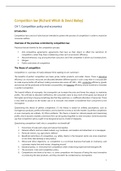Competition law [Richard Whish & David Bailey]
CH 1: Competition policy and economics
Introduction
Competition law consist of rules that are intended to protect the process of competition in order to maximise
consumer welfare.
Overview of the practices controlled by competition law
Practices that are harmful to the competition process:
▪ Anti-competitive agreements: agreements that have as their object or effect the restriction of
competition, unless they have a redeeming virtue such as economic efficiency.
▪ Abusive behaviour, e.g. pricing less than cost price, and if the competitor is driven out increase prices.
▪ Mergers
▪ Public restrictions of competition
The theory of competition
Competition is ‘a process of rivalry between firms seeking to win customers’ .
The benefits of perfect competition are lower prices, better products, and wider choice. There is allocative
efficiency (i.e. economic resources are allocated between different goods in such a way that it is not possible
to make anyone better off without making someone else worse off, MR = MC), productive efficiency (goods
and services will be produced at the lowest cost possible), and dynamic efficiency (more incentive to innovate)
in perfect competition.
The harmful effects of monopoly: the monopolist can increase the price and lower the output, to maximise
profits. This will lead to allocative inefficiency: the consumers want to buy more of the good, but because of
the higher price they’re buying something else that they want less, i.e. inefficient allocation of resources. There
is less need to produce at the lowest cost or to innovate. And wealth is transferred from consumers to the
monopolist.
Questioning the theory of perfect competition: (1) the theory is based on unlikely assumptions, such as
homogenous products, perfect information, and no barriers to entry or exit the market. So perfect competition
or pure monopoly are unlikely. (2) Other problems: The theory is based on rational people and maximising
profits. And in dynamic markets a dominant firm can be quickly engulfed in a new innovator. Some economists
say that competition policy ought to be designed around a model of oligopoly.
Questioning competition itself, why is competition not beneficial?
1. Economies of scale and scope and natural monopolies
2. Network effects and two-sided markets, e.g. Facebook, and readers and advertisers in a newspaper
3. Particular sectors, e.g. agriculture, defence
4. Beneficial restrictions of competition, e.g. safety checks in the transport sector are more important,
or two firms that develop a new product
5. Ethical and other objections, i.e. competition is a cut-throat business that leads to insolvency, and
customers waste time and money ‘shopping around’
6. Industrial policy, i.e. immunity from competition when researching expensive technologies (IP)
7. The economic crisis and competition policy
8. Competitions are there to be won, i.e. some competitors win because of being the most innovative
or producing the best products, and they shouldn’t be condemned as monopolists.
1
,There seems to be a direct causal relationship between industrial structure, the conduct of firms on the market
and the quality of their economic performance, i.e. ‘structure – conduct – performance’ paradigm. Other
empirical evidence is the Soviet Union: the effects of state planning and monopoly on the economic
performance were destructive.
The theory of the contestable markets states that if the market is ‘contestable’ (possible for firms to easily
enter and exit the market without costs), an optimal allocation of resources is ensured. Even if there is no
perfect competition (because there is not an infinite number of sellers on the market), because of the
possibility to entry and exit the market, the market will be efficient.
The idea of effective competition is that there should be some competitive constraints on the market, i.e. firms
are subject to constraints from actual and potential competitors, and customers.
Competition helps consumers get a good deal. It encourages firms to innovate by reducing slack, putting
downward pressure on costs and providing incentives for the efficient organisation of production.
The function of competition law
The goals of competition law: enhancing consumer welfare. Other objectives:
▪ Consumer protection
▪ Redistribution, i.e. economic equity instead of economic efficiency.
▪ Protecting competitors, i.e. the small guy should have a fair chance to succeed, but this can be
harmful to social and consumer welfare
▪ Single market integration, the negative role of competition law is preventing the isolation of a
domestic market by national cartels or export bans, and the positive role is encouraging trade
between Member States.
Market definition and market power
Market power is the possibility for a firm to raise prices. In a pure monopoly one firm has absolute control, in
a perfectly competitive market no firm has market power, and in between there is a continuum. There are two
key issues: (1) definition of the market, and (2) the identification of market power itself.
NO.1 – Market definition
It is necessary to define what the ‘market’ is where the ‘market’ power is present. An important test for defining
markets is the SSNIP test (i.e. hypothetical monopolist test), explained in the Notice on the definition of the
relevant market for the purposes of Competition law. The main purpose of market definition is to identify the
competitive constraints (i.e. competitors) that the involved undertakings face. Both the product dimension
and the geographical dimension of a market should be analysed. ▬ There are three main sources of
competitive constraints: demand substitutability (relevant for product market), supply substitutability (product
market and market power) and potential competition (market power).
The relevant product market should be defined by measuring interchangeability between products, e.g. if
bananas and other fresh fruit are interchangeable, they are on the same product market. The assessment of
demand substitution entails a determination of the range of products which are viewed as substitutes by the
consumer, i.e. the SSNIP test: Small but significant non-transitory increase in price. So if the price of product
X is increased with 5-10% and customers will change to product Y, the product market consists of product X
and Y. If after a price increase customers still buy product X, there is a monopoly, i.e. the hypothetical
monopoly test.
The ‘Cellophane fallacy’ means that if the monopolist already charges monopolistic prices, any price increase
will lead consumers to stop buying at all, suggesting substitutability with fake products and broadening the
market. Especially in Article 102 cases this fallacy can occur.
2
,A reverse Cellophane fallacy can occur if a SSNIP is applied to an unreasonably low (e.g. predatory) price: even
after a price increase consumers will buy for the low price, which leads to a market definition that is too
narrow.
The supply-side substitutability measures how easy it is for a producer to switch from producing one product
to another product, i.e. the market may be broadened to include those products.
Examples of evidence that may be used in defining the relevant product market:
▪ A price increase in the past
▪ Quantitative tests to estimate own-price elasticity and cross-price elasticities
▪ Views of customers and competitors
▪ Marketing studies
▪ Barriers and costs associated with switching to potential substitutes
▪ Different categories of customers and price discrimination
Problems with the Commission Notice:
1. It is not binding
2. The SSNIP test cannot be used in all cases, e.g. if no data are available for a new product or the service
is free to end users.
3. The relevant market must be defined by reference to the facts prevailing, and not by reference to
precedents.
Spare parts can form a separate market (e.g. cartridges to be used in a printer). Separate from the products
for which they are needed. However, if the ‘whole life cost’ of the product are taken into account, the markets
are not separate. ▬ In procurement markets (inkoop) the behaviour of the buyer is scrutinized, e.g.
supermarkets. There can also be a separate market for innovation, separate from products already on the
market.
The relevant geographic market has to be defined (case United Brands). Again the hypothetical monopolist
test is applied: if the price of product X in France is raised by a small but significant amount, would a sufficient
number of customers switch to suppliers in Germany and render the price increase unprofitable? Yes, then
the relevant market is France and Germany.
Examples of evidence are:
▪ Pas evidence of diversion of orders to other areas
▪ Basic demand characteristics such as culture and national preferences
▪ Views of customers and competitors
▪ Where customers currently purchase goods
▪ Trade flows
▪ Barriers and switching costs to deliver in another area
The temporal market when demand fluctuates from season to season. For example, demand for bananas
dropped in the summer season, so there could be two temporal markets: one for the summer season and one
for the rest of the year.
Market definition is not an end in itself, but a step in the process of determining whether a firm possesses
market power.
3
, NO. 2 – Market power
The three relevant issues to determine market power are summarized in Guidance on the Commission’s
enforcement priorities in applying Article 102 TFEU:
1. Actual competitors
Market shares do not include the firm that is not yet in the market, so market share figures are at best an
indication for market power (because potential competitors and countervailing buyer power are not taken
into account).
One way of determining the level of concentration in the market is to use the ‘Herfindahl-Hirschman Index’
(HHI), which sums up the squares of the individual market shares of all competitors, and the higher the total,
the more concentrated the market. The market concentration is low/middle/high if the concentration level is
<1000, 1000-1800, >1800. If the before-merger and after-merger concentration is calculated, the increase in
concentration is called Delta (Δ). The problem with the HHI is that it is a static approach.
2. Potential competitors
Potential entry by new firms must be taken into account, so the barriers to entry and barriers to expansion
are important. Barriers could be legal barriers (tariffs), advantages of the incumbents (economies of scale),
costs from network effects, or the conduct of a dominant undertaking (e.g. long-term exclusive contracts with
foreclosing effects).
3. Countervailing buyer power
Competitive constraints can also be exerted by customers with bargaining strength.
Market share thresholds:
<5%: no appreciable effect on trade between Member States
<10%: the effect of your agreements with competitors is de minimis
<15%: joint purchasing agreements or commercialisation agreements won’t infringe Article 101(1)
<20%: eligible for the simplified procedure for horizonal mergers
>20%: no more block exemption for these agreements: co-insurance, specialisation, technology transfer
>25%: no more block exemption for these agreements: R&D, co-reinsurance
<25%: presumption that your merger will not significantly impede effective competition
>30%: no more block exemption for vertical agreements
<30%: non-horizontal merger is unlikely to give rise to any problems under the EU merger regulation
<30%: eligible for the simplified procedure for vertical mergers
<40%: unlikely to be dominant under Article 102
<40%: if the total tied market share is less than 40% and all companies at the retail level have market shares
<30%, there is unlikely to be a cumulative foreclosure effect arising from single branding agreements
50%: legal presumption that you have dominant position
80%: position of super-dominance
90%: quasi-monopoly
100%: monopolist
4





